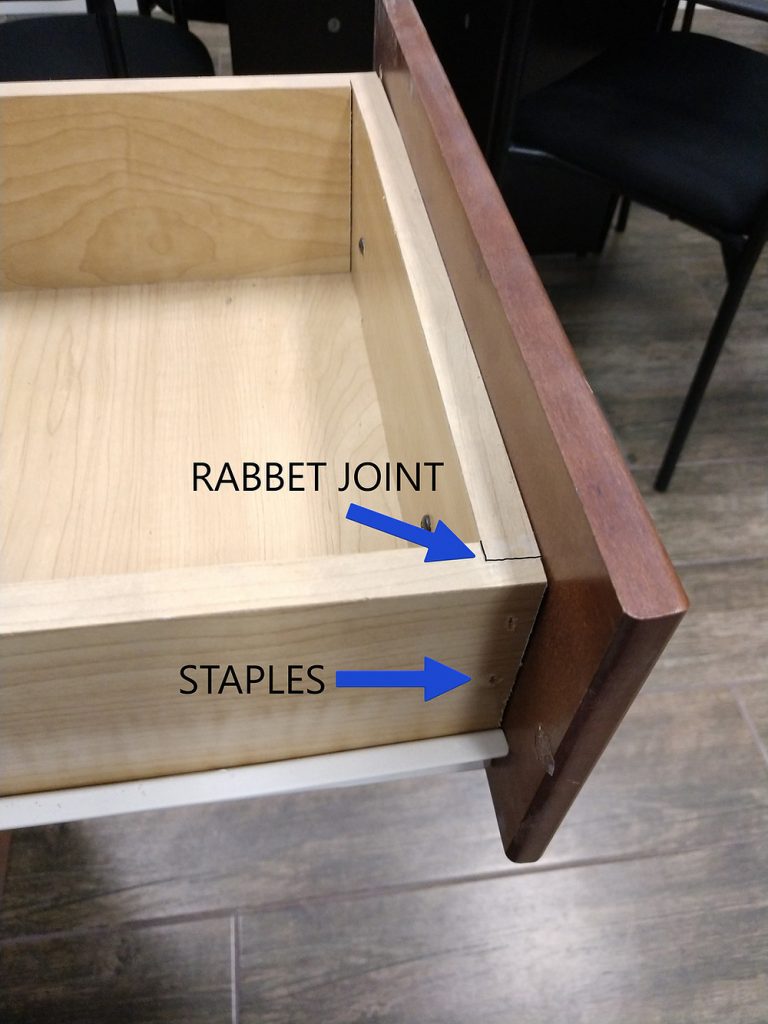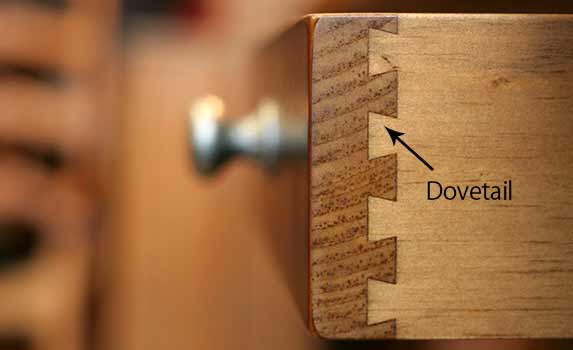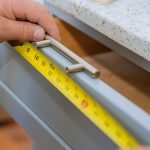What are dovetail drawers, and why do people prefer them so highly over standard drawers? The short answer: Durability. When you make a decision to go with dovetail drawers, you are essentially making a statement that you value quality and longevity. But there is surprisingly more to dovetail drawers than just a simple joint design. We’ll show you the ins and outs of dovetail drawers in this article. We’ll also highlight the benefits of dovetail drawers vs standard joint drawers.
To begin to think about the benefits of dovetail drawers, we need to think about what we really want our drawers to accomplish. And, of course, that answer is simple: We need them to hold our stuff! Whether in the kitchen, the bathroom, the bedroom, or even out in the shop or garage, they’ve got to hold up. We’re throwing pots and pans into our drawers daily. Maybe we’re loading one up with plumbing tools near the sink, just in case. Or what about that big sliding drawer that so conveniently hides away the few extra pairs of boots and shoes? The fact is, our drawers do a lot of work for us. And cheaply assembled drawers will break down. It’s not a matter of if, but a matter of when.
How can you tell a drawer is cheap, though? For starters, a dead giveaway would be that the drawer box is not wood, but perhaps PVC, particle board, or some other inexpensive, low-quality material. These materials have their time and place, but really have no business being anywhere near furniture you want to own for a long time. That’s doubly true if you’ll be using that drawer a lot! The second giveaway for a low-quality drawer is how its joints attach.

The second you notice a staple, nail, or screw holding your drawer box together, you should immediately consider replacing it with a dovetailed drawer. Now, maybe you don’t see any of those fasteners, and instead it seems that glue is holding those low-quality panels together instead. This is actually an even weaker joint! The strongest bond in drawer boxes like this is the one between the bottom panel and the four sides–and that’s only because of gravity. The second the glue on that panel begins to weaken, which it will with use, then the sides will begin to go with it. Basically, no cabinet drawer that overly depends on glue or staples deserves consideration as any kind of long-term option.
So: What makes dovetail drawers so much better? We’ll show you.
What Are Dovetail Drawers?
Chances are good that you’ve seen a dovetail drawer without even knowing you were looking at one! Historians say they’ve been around basically forever as an integral construction technique. According to Popular Mechanics, “Dovetail joints predate written history and can be found in the tombs of ancient Egyptian mummies and Chinese emperors.”
A sign of quality and solid construction, dovetail drawers have an interlocking design that creates a sturdy lock. This design, which includes “pins” and “tails” that fit tightly and precisely together, is a sign of solid craftsmanship. How dovetail drawers work: the tight, precise fit provides a high level of pressure (aka tensile strength). This pressure, especially in wood drawers, makes the drawer incredibly sturdy. Dovetail joints have such higher demand that it’s not uncommon for the interlocking pattern to remain visible, as proof of craftsmanship. This is a plain dovetail, though there are other methods too. Those methods include various means of hiding the dovetail.

Why Do People Prefer Dovetail Drawers?
It’s all about quality. Some drawer manufacturers are content to glue and staple their panels together. Though this method is cheaper up front, the value doesn’t last. These weaker joints break down over time, especially if the drawer is in use every day. The cost of fixing or replacing these cheaply made drawers is almost always higher than the initial investment in dovetail drawers.
When you opt for dovetail drawers, you’re basically making a statement. That statement says you value quality, and you want your cabinets and drawers to stand the test of time. Sometimes you can tell a dovetail drawer by the telltale interlocking “checkerboard” pattern. Occasionally, the manufacturer will hide the pattern. But most importantly, these drawers do not easily wear down at the joints. They withstand constant heavy weight and daily use, which makes them fantastic in closets and kitchens.
Components of Dovetail Drawers
While dovetail drawers are high-quality, they basically have a few primary things in common with every other kind of drawer. Namely, the principle components are the same, with the difference being in the joints. Those components are the front (or face), the slides, and the box.
- Drawer Front: This is the obvious and visible part you see when the drawer is not open. It attaches to the front of a drawer box and often can be an entirely different material or color than the cabinet box itself. It’s actually fairly uncommon for the entire drawer to match the style and material of the face.
- Drawer Slides: Of course, the drawer needs some way to slide smoothly into the cabinet space. Slides attach to the bottom or sides of the drawer and fit into rails to allow movement. You can buy side-mount, under-mount, Euro, or other styles. But under-mount slides can include “soft-close” technology, which makes them very desirable. Soft-close features hydraulic dampening that helps the drawer consistently slide in smoothly and quietly.
- Drawer Box: This is where dovetails come in. The drawer box is the box or container part of the drawer that, well, contains whatever you choose to put in it. Its back, front, and side panels all attach to each other in various methods. Of course, our interest in this article is the dovetail joint.
Drawer Materials and Why It Matters
In most cases, if you want a drawer to last, you’ll stay away from the cheaper options like PVC or especially particle board. These drawers simply don’t stand up to heavy use. If you’ve ever gone through a move with a piece of big-box store furniture, you get the idea. The bottom of a drawer box is quite commonly plywood, but because it has such strong reinforcement, its rarely encounters problems. Plywood side panels, however, fare quite a bit worse. So, our recommendation would be to go with wood drawers, especially since that unlocks the option of the dovetail joint.
Your own personal style and preference will dictate which wood is best for your drawers. But different woods will provide slightly different results and characteristics, so you should know what you want to get out of it. For example, walnut is extremely expensive because its high sap content naturally makes it very streaky. Most consumers don’t want those unsightly streaks in their furniture, so manufacturers process walnut much more than they do other woods. If you choose walnut, you’ll either pay up, or you’ll get irregularities if you go cheap.
For drawer boxes, though, hardwoods are extremely popular. Many consider them the best choice for this purpose, with oak being especially popular. But truly, any selection from cherry, poplar, cedar, maple, walnut, birch, beech, or ash will all work great. And, even better, all become stronger when fastened with a dovetail joint!
Lastly, if you are making or replacing cabinet drawers with luxury in mind, a dovetail joint is basically a necessity. You can splurge on a number of other items that will transform a cabinet into an heirloom–like undermounted, soft-close sliders–but make sure you start with a quality drawer box.
Dovetail Details
So how do manufacturers make dovetail drawers, exactly? Glad you asked! There are several different options for making the dovetail joint. Typically it involves triangular wedges and corresponding notches cut out. The pieces fit together much the way a jigsaw puzzle might. One key about these notches, though, is that they angle in (resembling, you guessed it, a dovetail). This design is an “English dovetail.” The benefit of this style is that it creates an extremely tight and secure interlocking joint when the “tabs” interlock with the cutouts. Sometimes people call these pins and tails, but no matter what you call them, the point is: They’re strong!
The joint becomes even stronger when reinforced with wood glue. Beware if you are looking for dovetail drawers and come across “French dovetails.” This style features only one wedge and one single groove, which obviously is nowhere near as strong as the English style.
Another key benefit of dovetail drawers is that the interlocking joints they use create more surface area at the joint. Consider a French dovetail, which has just one tab where it connects to a pin in another panel. While you could reinforce that joint with wood glue, you would have three sides of surface area to connect only–the sides of the pin, of course. With an English dovetail, though, and its many interlocking joints, you multiply the surface area available. This not only creates more friction and strength at the joints, but also more surface area for gluing. Ultimately, dovetail drawers ensure a rock-solid construction that will hold up to heavy use. When most dovetail drawers break, in fact, it’s almost never because of the drawer box, but because the face panel or hardware wore down.
Compare this kind of extremely strong construction to simple staples or glue, which bind only the edges of the panels along a thin surface area. It should be obvious that nobody who wants their cabinets drawers to last a long time should consider this method! That is especially true when considering how superior the dovetail method is. For strength and storage space, it really isn’t a decision.
How Can I Make My Own?
Those who take on the task of making their own dovetail drawers are accepting a challenge, but a gratifying and worthwhile one. While we’d recommend looking over Fast Cabinet Doors’ selection of dovetail drawer boxes, you certainly could find it rewarding to do your own. Though people have been hand-making this type of joint for thousands of years, you might find it less intimidating to use a router and a jig, or even a table saw, to create your own pins and tabs.
The Verdict on Dovetail Drawers
You’ve probably figured it out by now. If you want high-quality drawers that will last you a long time, dovetail joints are the way to go. This style will work with almost any kind of wood, but typically, birch is the least expensive wood option. Keep in mind that once you select your dovetail drawers, you probably will be using them forever! A quality drawer should stand up to anything you can throw at it. They truly stand the test of time.





